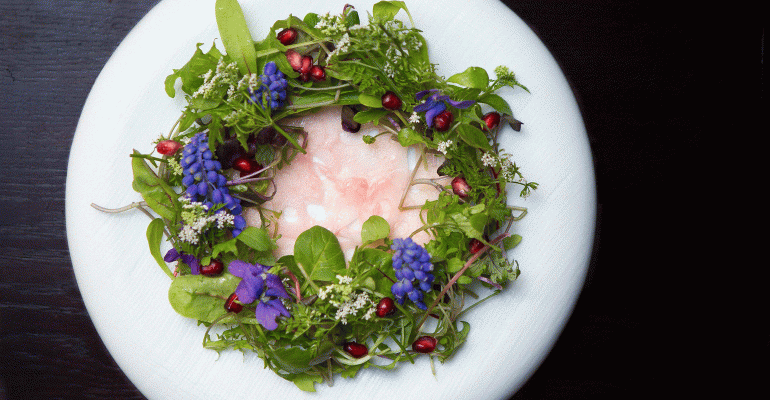Chef and restauranteur Cara Stadler is a huge fan of lotus root, the underwater Asian root vegetable known for its unusual, lace-like interior and sometimes for its bitter or, some say, swampy, flavor.
“There is a swampiness to lotus. The product is where it comes from,” said Stadler. “Once it’s fried and crispy, I think it’s delicious.”
Stadler almost always has lotus root on the menu at her BaoBao Dumpling House in Brunswick, Maine, and often at Tao Yuan, her Asian-fusion restaurant, also in Brunswick.
Despite its “swampiness,” Stadler loves the extremely starchy texture, which she says makes it ideal for experimenting. Her preferred preparation is frying it like a potato, but she also likes grinding it into a starch and deep frying it like a donut, pounding it into a pancake or making it into pickles. She describes the edible leaves as a “phenomenal” vehicle for cooking, and often uses them as a wrapper when steaming sticky rice or grilling fish.
But in Maine, she says, accessing high-quality lotus root, which is grown primarily in China, Japan, India, Indonesia and the Philippines, can be a challenge.
“If I could have more access, I think I’d have them more often,” she said.
So when Stadler received a call last year from a local man inviting her to his property to harvest lotus root from his pond, she didn’t hesitate to say yes.
Even though she had to don a full-body wet suit to wade in murky water on a 50-degree day to dig up from the silt a meager amount of the root, Stadler is still enchanted by the lotus.
“One of my pipe dreams is to start a lotus root farm,” she said.
Of course, Stadler isn’t the only chef who likes and is menuing lotus root.
At Hwaban, a soon-to-open Korean restaurant in New York City’s Flatiron district, chef and restaurateur Mihyun Han will be serving a vibrant lotus root salad. Han thinly slices and then lightly pickles lotus root in a sweet vinegar to preserve its white color and offset any bitterness, then dresses the root and baby greens with a fruit vinaigrette and garnishes the plate with edible flowers.
“This salad was created as a great starter which emphasizes good health, according to the ideas of Eastern medicinal practice, and great summer taste with excellent texture,” Han said.
In Los Angeles, OMSB, a Japanese fast-casual build-your-own rice ball restaurant, offers the Kinipira, a lotus root and carrot rice ball.
At Hakkasan New York, a modern Cantonese restaurant, guests can enjoy lotus root several ways, including in a bean curd roll and stir-fried with asparagus and black pepper. The restaurant also wraps sticky rice in lotus leaves.
In Chicago, Sushi-San, a Japanese restaurant focused on raw fish, offers a crispy ginger and salmon maki roll made with Faroe Island salmon, pickled lotus root, wasabi aïoli and tempura crunch, topped with fried ginger threads.
While lotus root is predominately found at restaurants serving Asian cuisine, Instagram is full of lotus lovers posting pics of their favorite preps, an indication that the unusual ingredient may soon find its way onto more — and different types — of menus.
More than 34,000 ’grams tagged #lotusroot showcase the Asian root vegetable in everything from beverages to soups, prepared stir-fried, braised, deep fried or stuffed (or both) and more.
Brooklyn, N.Y.-based photographer, writer and cookbook author Julia Sherman, in late July posted, “@nytimes makes a great background for fried #lotusroot.”
Wild Hibiscus, a global producer of food and drinks made from flowers, posted in July, “Happy with our @wildhibiscusco Lotus Root garnish looking very artsy.”
The lotus garnish appeared in a photo of the company’s Butterfly Pea Flower Cocktail in a coup glass to promote a tasting event to be held in New Orleans.
San Francisco, Calif-based Namiko Chen, founder of justonecookbook.com, an online guide to Japanese cooking, posted in March a how-to video for making a Japanese dish of fried lotus root stuffed with miso and hot mustard.





